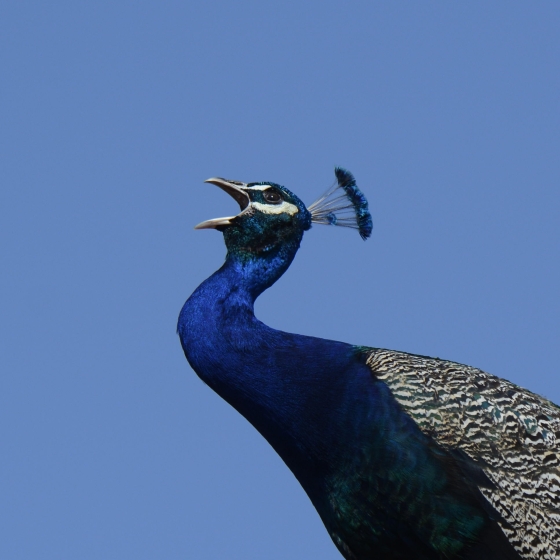Indian Peafowl
Pavo cristatus (Linnaeus, 1758)
PX
 INDPE
INDPE  35670
35670

Family: Galliformes > Phasianidae

The Indian Peafowl, will be familiar as an ornamental species, often associated with stately homes, but the free-flying nature and tendency to wander some distance mean that individuals can turn up elsewhere.
Inclusion of the species in Bird Atlas 2007–11 was a step forward in being able to establish the distribution of this species and the extent to which it has naturalized.
Identification
Indian Peafowl identification is usually straightforward.
Develop your bird ID skills with our training courses
Our interactive online courses are a great way to develop your bird identification skills, whether you're new to the hobby or a competent birder looking to hone your abilities.
Browse training coursesStatus and Trends
Population size and trends and patterns of distribution based on BTO surveys and atlases with data collected by BTO volunteers.
POPULATION SIZE
We have no population estimates for this scarce species.
| BOU Category | E |
DISTRIBUTION
The Indian Peafowl is familiar to many as an ornamental species associated with stately homes, ornamental parks and country estates. These birds are usually free-flying and many individuals wander some distance and attempt to breed in the wild. Historically, such birds have not been routinely documented because birdwatchers tend not to record exotic species, and judging when birds are wild-ranging is problematic. These maps show the extensive nature of winter and breeding distributions and are probably underestimates of the true status of this species.
Occupied 10-km squares in UK
| No. occupied in breeding season | 136 |
| % occupied in breeding season | 4.5 |
| No. occupied in winter | 108 |
| % occupied in winter | 3.6 |
DISTRIBUTION CHANGE
No previous atlas records exist for this species so it is impossible to assess changes in range.
SEASONALITY
Indian Peafowl is a naturalised non-native and present throughout the year.

Movement
Information about movement and migration based on online bird portals (e.g. BirdTrack), Ringing schemes and tracking studies.
RINGING RECOVERIES
View a summary of recoveries in the Online Ringing Report.
Biology
Lifecycle and body size information about Indian Peafowl, including statistics on nesting, eggs and lifespan based on BTO ringing and nest recording data.
PRODUCTIVITY & NESTING
Sample sizes are too small to report Productivity and Nesting statistics for this species.
BIOMETRICS
Sample sizes are too small to report Biometrics for this species.
Feather measurements and photos on featherbase 
CODES & CLASSIFICATION
Field Codes 
|
2-letter: PX | 5-letter code: INDPE | Euring: 35670 |
For information in another language (where available) click on a linked name
Would you like to search for another species?






Share this page